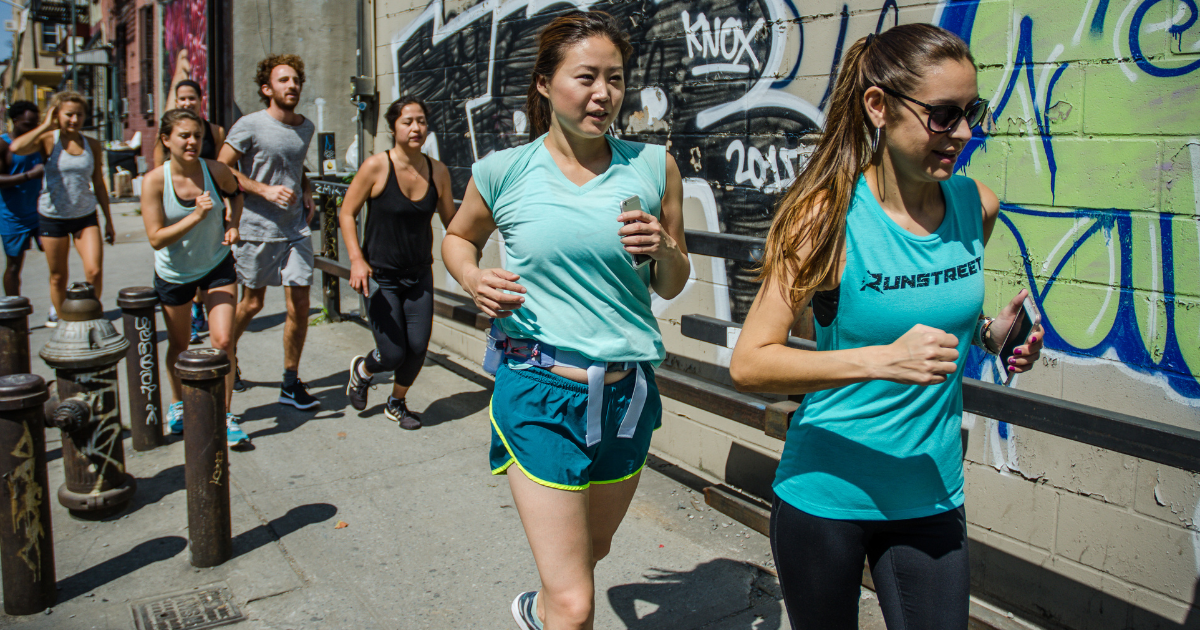20 Running Training Tips that Will Change Your Life
Photos by Marques Jackson Photography.
By Marnie Kunz,
Certified run coach and personal trainer
Whether you’re a new runner or training for the Boston Marathon, these running training tips will help you become a better runner. As a running coach, I often get asked by runners how they can get faster or run injury-free. I’ve collected my best training tips to help you become a better athlete and runner. Whether you’re just starting out or are an intermediate runner already tackling half marathons and marathons, these tips will help you step up your game. If you need a training plan to help you slay your running goal, visit the Runstreet Training Center. Whether you need help tackling a 5K or running your fastest marathon, I offer a range of running plans, from a Beginner 5K Training Plan to the most popular plan, a Customized Marathon Training Plan.
Running Training Tips to Become a Better Athlete
Incorporate these running training tips into your fitness routine, and you’ll start seeing results. With these training strategies, you can improve your running form, reduce your risk of injury, and run faster and farther.
1. Wear the Right Shoes
There is no one pair of “best running shoes,” but instead, it’s important to find the shoes that work best for your foot type, gait, training conditions, and comfort. If you’re a new runner or your old running shoes are feeling flat and worn, it’s time to get fitted for new shoes. Visit a local running store to get fitted for running shoes so you can hit the ground running strong.
Related Post: How to Find the Best Running Shoes
Use this checklist to dress for your runs.
2. Dress for Success
The only other equipment you need for your running training program is running clothes. Moisture-wicking athletic clothes will help you stay dry and comfortable on your runs. Dress in layers so you can peel off your top layer if you get too warm. I also recommend wearing a hat, sunglasses, and sunscreen for protection from the elements.
Related Post: What to Wear Running - Checklist from a Run Coach
3. Start Small
Whether you’re new to running or just starting back after an injury, it’s important to build your fitness base gradually so you don’t get injured or burned out. The beginning phase of your training should include base miles, which means you’re running at a relaxed, conversational pace, also called zone 2 training.
Doing base runs will help build your general fitness level and prepare you for more intense workouts as you continue your running training. If you’re a beginner runner, you can incorporate walking breaks into your runs and gradually reduce your walking time as you run more. Adding more mileage to your training incrementally will improve your fitness level while minimizing your risk of injuries.
4. Build Gradually
As any good training plan will demonstrate, the key to becoming a better runner is to add more intensity or miles to your training by following the principle of progressive overload. The principle states that you should add no more than 10 percent more distance or intensity to your workouts from week to week, according to the National Academy of Sports Medicine. Progressive overload allows your body to get stronger and faster while rising to the challenge of harder workouts without overtraining and risking injuries.
Related Post: What Is Overtraining and How to Avoid It
5. Follow a Training Plan
A running plan gives you the blueprint you need to meet your running goals. Whether you want to run your first 5K or get your best marathon time, a training schedule gives you a map to achieve your goal.
Related Post: 15 Best Half Marathon Races in the World
6. Track Your Progress
Use a running app or smartwatch to track your runs. This will help you see your average pace and stats, and your running training progress. Many free running apps are available that you can download on your smartphone and use to track your runs.
7. Schedule Your Runs
One of the most common problems I see with runners is missing workouts or becoming “too busy” to run. Planning out when you will run and for how long will help you stay on track with your training and reduce skipped workouts. Schedule your runs for the time of day that is most convenient for you, and you’ll be more likely to stick to your workout program.
8. Eat Well
Good nutrition is essential to fuel your running training. Eat a variety of minimally processed foods, including complex carbohydrates, lean protein foods, and lots of fruits and vegetables. Cut back on highly processed foods and instead eat a colorful diet with fresh produce and foods like sweet potatoes, quinoa, leafy greens, whole grain bread, bananas, brown rice, berries, and lentils.
Related Post: When and How to Carb Load
Try these tips for better muscle recovery.
9. Hydrate
Hydration is so important for runners. Staying hydrated helps prevent muscle cramps and fatigue and allows you to run at your best. Drink a minimum of 16 ounces (2 cups) of water before your run to boost your hydration. The American Council on Exercise recommends 17 to 20 ounces (up to 2.5 cups) of water two hours before exercising.
During your run, drink about 8 ounces of water (1 cup) every 20 minutes. You can take a small sip or two every 10 minutes or a few long drinks every 20 minutes. After running, replenish lost fluids by drinking 16 to 24 ounces for every pound of body weight lost after exercise. Have at least 16 ounces (2 cups) of water within the first 30 minutes after your run.
10. Take Rest Days
Regular rest days allow your body to recover from the stress of training. Rest is crucial to prevent injuries and burnout. Most training plans include at least one day of rest per week for muscle recovery.
11. Cross Train
Cross training for runners means doing any exercise other than running. I usually suggest low-impact exercises to give your body a break from the impact of pounding the pavement. Exercises like yoga, pilates, swimming, cycling, walking, and hiking offer great cross training workouts for runners.
12. Strength Train
Strength training is an often overlooked part of training for many runners who don’t realize all the benefits they’re missing out on. Doing just one or two strength workouts per week can improve your muscle strength and help you run faster and with better running form and stability. Strength training also helps combat muscle loss that comes with aging.
Here is a sample bodyweight workout you can do:
Squats
Lunges
Pushups
Seated dips
Planks - 30 seconds
Do 2 to 3 sets of 10 for each exercise (except for planks, do 2 to 3 sets of 30-second planks).
13. Listen to Your Body
Try this beginning tempo run for a speed workout.
This sounds like a cliche, but the advice to listen to your body is popular for a reason - it works. Listening to your body can help you take an extra rest day when you need it or push the pace when you’re feeling good. When your body needs a break from training, you’ll feel lingering aches and pains, and taking some time to rest can help prevent these from turning into injuries.
14. Do Speed Workouts
If you’re an experienced runner, you may have some race time goals. Speed workouts can help you hit your goal race pace and perform at your best. Add one to two speed workouts per week to your running training routine to get faster.
Most speed workouts fall into two categories - tempo runs and intervals. A tempo run is a steady state effort run that should feel “comfortably hard,” at about 80 percent effort level. After a few minutes of jogging and dynamic stretches to warm up, run at your tempo pace for at least 20 minutes before cooling down. For most runners, a good tempo pace is your 10K race pace, which you could maintain for up to an hour, but with some effort.
Intervals involve short bursts of speed followed by periods of slow recovery running. For more details on how to do interval workouts, check out my post on Interval Training for Beginners with Sample Workouts.
If you’re training for your first race, on the other hand, don’t worry about speed training as your primary goal will be to finish the race. You can always add speed workouts to your program later after you get some races under your belt.
15. Run Farther
Training for longer races requires plenty of endurance. If you’re training for a half marathon or marathon, do a weekly long run to build your stamina. Your training plan should include long runs that gradually increase in distance over time, preparing your body for race day.
Running with a group makes workouts more fun.
16. Run with Others
Running with people makes workouts more enjoyable, and you can pick up insights on everything from local races to the best running fuel from fellow runners. Join a local running group or invite a friend or family member to run with you to add more fun - and accountability - to your runs.
17. Get Motivated
Running is a mental sport, and motivation can make or break your runs. Do what you need to do to get yourself excited about running. Read a running book, create a pumped up playlist, and share your workouts to help you get motivated to run.
18. Set Running Goals.
It’s easy to get caught up in a running routine of doing the same workouts day after day. Setting a goal can help you push yourself to do more challenging workouts and races. Set SMART goals that are specific, measurable, attainable, realistic, and timely. Being specific with your goals will help you track your progress and get better results.
Get more tips on How to Set SMART Running Goals and enjoy the rewards.
19. Mix Up Your Routine
Try running in new places or sign up for some fun vacation races to add variety to your routine. If you normally run on roads, sign up for a trail race and start training for it. If you usually run with a group, try running alone sometimes. Changing your routine can help you stay inspired in your training and keep you motivated.
Related Post: Best Trail Running Tips for Beginners
20. Celebrate Your Milestones
Celebrate your running achievements as you make progress. Runners are often too hard on themselves and downplay their accomplishments. Focusing on your achievements can help build your confidence so you can tackle more challenging races and experiences. Whenever you feel down about your training, check out your training stats and see how far you’ve literally come from the time you started.
Need a training plan to help you achieve your big running goal? Visit the Runstreet Training Center and I’ll be happy to help you with a personalized training plan. Follow and tag @Runstreet on Instagram to share your workouts and get cheered on. Happy running to you - here’s to many beautiful miles ahead!
Related Posts: All Your 10K Questions Answered, 10 Best Vacation Races, Half Marathon Training Plan for Beginning Runners
Marnie Kunz is a NASM-certified trainer and USATF- and RRCA-certified running coach based in Brooklyn, NY. Marnie likes helping people get and stay active to enjoy a better quality of life. When she’s not doing fitness things, Marnie enjoys reading and exploring with her dog, a mischievous rescue Akita.







